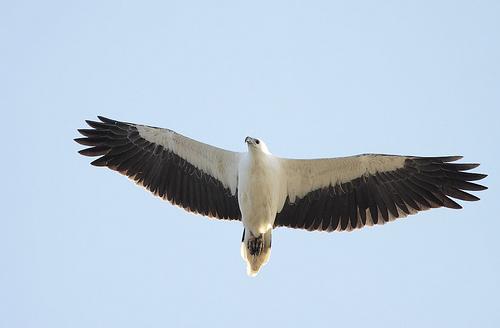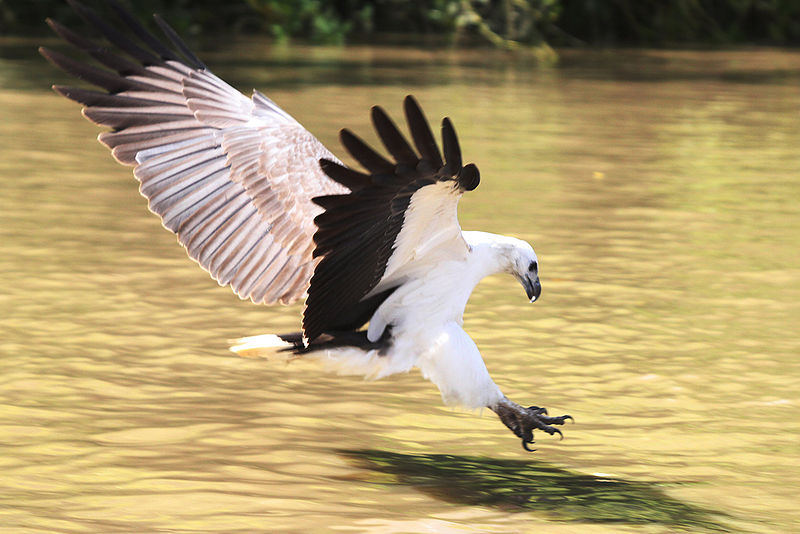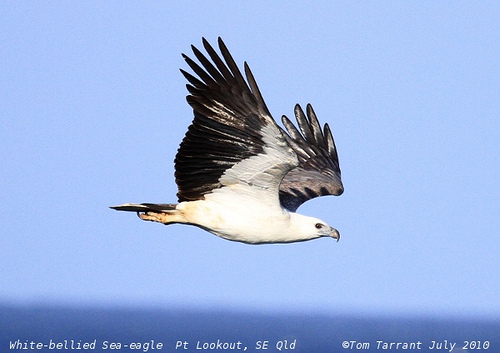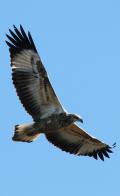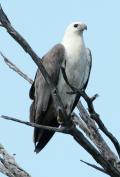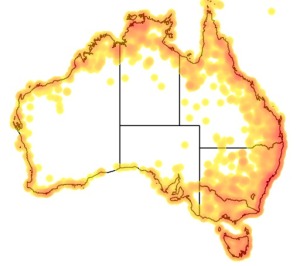Colours
Distinguishing features
Adults have a white head, rump and underparts, and dark or slate-grey back and wings. In flight, the black flight feathers on the wings are easily seen when the bird is viewed from below.
The large, hooked bill is a leaden blue-grey with a darker tip, and the irides are dark brown. The cere is also lead grey. The legs and feet are yellow or grey, with long black talons (claws).
Unlike those of eagles of the genus Aquila, the legs are not feathered. The sexes are similar though females are slightly larger. Also birds from latitudes further south were larger than those from the north.
There is no seasonal variation in plumage. The moulting pattern of the White-breasted Sea Eagle is poorly known. It appears to take longer than a year to complete, and can be interrupted and later resumed from the point of interruption.
The wings are modified when gliding so that they rise from the body at an angle, but are closer to horizontal further along the wingspan. In silhouette, the comparatively long neck, head and beak stick out from the front almost as far as the tail does behind. For active flight, the White-bellied Sea Eagle alternates strong deep wing-beats with short periods of gliding.
A young White-bellied Sea Eagle in its first year is predominantly brown, with pale cream-streaked plumage on their head, neck, nape and rump areas. The plumage becomes more infiltrated with white until it acquires the complete adult plumage by the fourth or fifth year. (Wikipedia)
Size
- From 66 cm to 80 cm (Length of specimen) - applies to Males
- From 80 cm to 90 cm (Length of specimen) - applies to Females
Wingspan
- From 178 cm to 220 cm
Synonyms
Distribution
Distribution and habitat preferences
The White-bellied Sea Eagle is found regularly from Mumbai (sometimes north to Gujarat, and in the past in the Lakshadweep Islands) eastwards in India, Bangladesh, and Sri Lanka in southern Asia, through all of coastal Southeast Asia including Burma, Thailand, Malaysia, Indonesia, Indochina, the main and offshore islands of the Philippines, and southern China including Hong Kong, Hainan and Fuzhou, eastwards through New Guinea and the Bismarck Archipelago, and Australia. In the northern Solomons it is restricted to Nissan Island, and replaced elsewhere by Sanford's Sea Eagle. In Victoria, where it is otherwise scarce, it is locally more common at Corner Inlet and Gippsland Lakes. Similarly in South Australia, it is most abundant along the north coast of Kangaroo Island. The range extends to the islands of Bass Strait and Tasmania, and it is thought able to move between the islands and the mainland. There is one unconfirmed record from Lord Howe Island and several from New Zealand. (Wikipedia)
They are a common sight in coastal areas, but may also be seen well inland. (Wikipedia)
Audio recordings
Diet
It is an opportunistic carnivore and consumes a wide variety of animal prey, including carrion. It often catches a fish by flying low over the water and grasping it in its talons. It prepares for the strike by holding its feet far forward (almost under its chin) and then strikes backwards while simultaneously beating its wings to lift upwards. Generally only one foot is used to seize prey.
It may also dive at a 45 degree angle from its perch and briefly submerge to catch fish near the water surface. While hunting over water on sunny days, it often flies directly into the sun or at right angles to it, seemingly to avoid casting shadows over the water and hence alerting potential prey. (Wikipedia)
It hunts mainly aquatic animals, such as fish, turtles and sea snakes, but it takes birds, such as Little Penguins, Eurasian Coots and shearwaters, and mammals as well.
In the Bismarck Archipelago it has been reported feeding on two possum species, the Northern Common Cuscus and Common Spotted Cuscus.
It is a skilled hunter, and will attack prey up to the size of a swan. They also feed on carrion such as dead sheep, birds and fish found along the waterline, as well as raiding fishing nets and following cane harvesters.
They harass smaller raptors such as Swamp Harriers, Whistling Kites, Brahminy Kites and Ospreys, forcing them to drop any food that they are carrying. Other birds victimised include Silver and Pacific Gulls, cormorants and Australasian Gannets. The White-bellied Sea Eagle attacks these birds by striking them with outstretched talons from above or by flying upside down underneath the smaller predator and snatching the prey, all the while screeching shrilly.
White-bellied Sea Eagles feed alone, in pairs, or in family groups. A pair may cooperate to hunt.
Prey can be eaten while the bird is flying or when it lands on a raised platform such as its nest. The White-bellied Sea Eagle skins the victim as it eats it. It is exceptionally efficient at digesting its food, and disgorges only tiny pellets of fragmented bone, fur and feathers. (Wikipedia)
